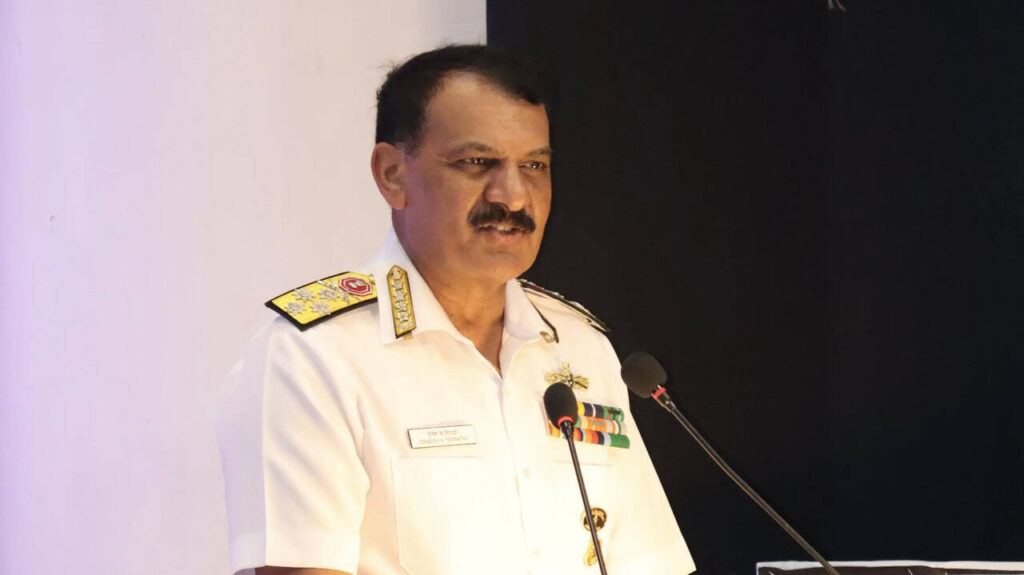India’s Navy charts a new course from SAGAR to MAHASAGAR at IPRD-2025.
Photo : Times Now
The Indian Navy has unveiled a broadened maritime vision that looks beyond regional waters to embrace a truly global outlook, as Chief of Naval Staff Admiral Dinesh K Tripathi inaugurated the seventh edition of the Indo-Pacific Regional Dialogue (IPRD-2025) in New Delhi on Monday.
Welcoming over thirty international delegates from friendly nations, the Navy Chief described the forum as “a vital expression of the Indian Navy’s strategic outreach” and a platform to shape the Indo-Pacific’s future “through dialogue, cooperation and mutual trust.”
From SAGAR to MAHASAGAR: India’s Expanding Maritime Vision
Reaffirming India’s maritime leadership, the Admiral announced the evolution of the country’s oceanic strategy from SAGAR — Security and Growth for All in the Region — to MAHASAGAR, or Mutual and Holistic Advancement for Security and Growth Across Regions.
“This evolution from Sea to Ocean,” he said, “signifies both expansion of scope and depth of purpose.” The Indian Navy, as the “principal manifestation of India’s maritime power,” remains at the forefront of operationalising this vision through cooperative engagement, capacity-building and regional partnerships.
This year’s IPRD, themed around “Holistic Maritime Security, Regional Capacity-Building and Capability Enhancement,” aims to strengthen the core pillars of the Indo-Pacific Oceans Initiative (IPOI).
‘Seas Have Always Been Humanity’s Oldest Highways’
Setting the tone for the conference, the CNS reflected on the enduring role of the seas as carriers of “commerce, culture, curiosity, and courage.”
Quoting Prime Minister Narendra Modi, he emphasised that “oceans are a shared heritage and the lifeline of international trade,” underscoring that peace and prosperity on the seas are inseparable.
Maritime Security: A ‘Dynaxic’ Challenge
In a world of fluid alignments and fused challenges, maritime security, the Admiral said, must no longer be viewed through the narrow prism of threat containment but as a “Dynaxic Challenge” — one that is dynamic and complex.
He identified three defining currents shaping this new maritime order:
1. Commercial Disruption
Global seaborne trade is expected to plunge to 0.5% growth in 2025, from 2.2% last year — signalling strategic fragility.
“The Red Sea crisis has shown how one chokepoint can ripple across global freight indices, insurance premiums, and food prices,” the CNS noted.
2. Transnational Turbulence
The seas are witnessing a surge in Illegal, Unreported and Unregulated (IUU) fishing, piracy, arms and narcotics trafficking, and human smuggling.
According to the FAO, IUU fishing causes losses of 11 to 26 million tonnes of fish annually, valued between USD 10 to 23 billion.
“Smuggling networks are exploiting ungoverned maritime spaces to move arms, narcotics and sanctioned commodities — financing terror and fuelling instability,” he cautioned.
He also highlighted the compounded threat of rising sea levels, extreme weather and marine pollution, particularly for Small Island Developing States (SIDS).
3. Technological Acceleration
Emerging technologies such as AI, autonomous systems and commercial satellites are reshaping maritime operations, but they also bring new vulnerabilities.
“Recent IFC-IOR assessments have recorded near-daily episodes of GPS jamming and electronic interference in the Indian Ocean Region,” the Admiral revealed.
“Maritime security and maritime growth are not parallel tracks,” he said. “They are twin propellers that drive our collective voyage towards peace and prosperity.”
Building the Trinity: Security, Capacity, Capability
Holistic Maritime Security
CNS called for viewing maritime security as “an interconnected web” that integrates deterrence, governance, law enforcement, environmental stewardship, and humanitarian response.
He cited the Africa-India Key Maritime Engagement (AIKEYME) exercise with nine African nations and the Information Fusion Centre–Indian Ocean Region (IFC-IOR) in Gurugram as models of cooperative engagement.
The IFC-IOR, already hosting 15 International Liaison Officers, will expand to 50 by 2028, enhancing information-sharing and response coordination.
“Holistic maritime security must reconcile inclusivity with individuality,” he stressed. “Every nation, large or small, must contribute according to its capacity while drawing strength from collective purpose.”
Regional Capacity-Building
Defining capacity as “tangibles expressed in hulls, airframes, ports and industrial ecosystems,” the CNS called for distributed and complementary regional capacities.
He highlighted the Deep Submergence Rescue Vessel (DSRV)’s successful interoperability with foreign submarines during Exercise Pacific Reach, and the development of NISHAR-MITRA terminals for secure intelligence sharing among partner navies.
“True capacity is not what a nation accumulates,” he asserted, “but what a region aggregates.”
Capability Enhancement
The Admiral emphasised that “capability resides not in assets alone, but in how they are employed.” He urged a shift from platform-centric to purpose-centric thinking, promoting doctrines that anticipate hybrid threats and training that fosters initiative and adaptability.
He cited the month-long IOS Sagar deployment to the Southwest Indian Ocean — crewed by 44 personnel from nine IOR nations — as a pioneering step in multinational naval cooperation.
‘No Problem Can Withstand Sustained Thinking’
Concluding his address, the CNS called the IPRD “an ideal forum to convert collective ideas into collaborative action.”
Expressing confidence that the dialogue would “create new convergences,” he invoked Voltaire’s words — “no problem can withstand the assault of sustained thinking.”
“May IPRD-2025 help us sail beyond the turbulence of the present,” he said, “into the tranquillity of a secure and sustainable maritime future.”



